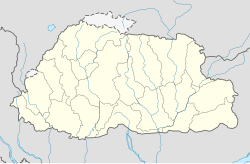| Punakha སྤུ་ ན་ ཁ་ | ||
 | ||
| State | Bhutan | |
|---|---|---|
| Altitude | 1,200 m a.s.l. | |
| Inhabitants | 7.000 (2005 estimate) | |
| Prefix tel | 975 | |
| Time zone | UTC 6 | |
Position
| ||
Punakha (སྤུ་ ན་ ཁ་) is a city of Western Bhutan.
To know
Punakha was the capital of Bhutan from the 17th century until 1955, when that role passed to Thimphu. When you visit the city you still feel a regal and tranquil aura. The dzong and the remains of the unifying ruler Ngawang Namgyal are the main attractions in Punakha, although there are other sites to see and things to do. Punakha is part of the triad of Bhutan's three most visited tourist destinations, along with Jakar is Paro.
Background
Punhaka dzong, built between 1637 and 1638, is the winter residence of Bhutan's Central Monk Body.
In 1907 the Punakha Dzong was the coronation site of the first king of Bhutan: Ugyen Wangchuck (or Deb Nagpo). Three years later a treaty was signed here with the British crown of British non-interference in Bhutanese internal affairs in exchange for the British crown's handling of external affairs. In 1987 the dzong was partially destroyed by a fire.
Due to the location of the dzong, at the confluence of the Pho Chhu and Mo Chhu rivers in the Punakha-Wangdue valley, it is vulnerable to flooding caused by the melting of the glaciers above. The last natural disasters date back to 1957, 1960 and 1994.
How to orient yourself
How to get
By car
You can get on a taxi or bus from the capital, Thimphu. The trip from Thimphu takes between one and a half to two hours. Shared taxis stop at (and depart from) Khuruthang , which is located about 5 km south of Punakha.
How to get around
All of the city's attractions (including the dzong) are within walking distance.
By taxi
There is a taxi near the dzong, where taxis can be hired to visit sites of interest outside the city, but within the valley.
What see

- Punakha dzong. Majestically built on an island between the confluence of the Pho Chhu and Mo Chhu rivers, the city's dzong is one of the most photographed of all Bhutan's ancient fortresses, and you'll see its photos hanging in hotels and restaurants across the country. The dzong is joined to the mainland by an arched wooden bridge and contains many precious relics from the times when successive kings ruled from this valley. The dzong serves as the winter home of the monastic body.
- 1 Suspended bridge (Behind the dzong). A pedestrian suspension bridge of almost 250 meters along one of the Mochu / Phochu rivers. It has a very beautiful and serene location, perfect for sitting and watching the river flow. Many people don't visit it, but those who did consider it a must.
- 2 Chimi Lhakhang. Set amidst beautiful rice fields, it is one of the most scenically located monasteries in eastern Bhutan and takes about half an hour to walk to the monastery from the road. The best time of day to visit is early in the morning. It was founded by Drukpa Kunley, who was also credited with introducing the practice of phallic paintings to the country and placing phallic statues on roofs to ward off evil spirits.
Events and parties
What to do
- Trekking. You can go trekking everywhere around Punakha. Crime is practically non-existent so you can walk in complete peace of mind for hours and hours.
Shopping
How to have fun
Where to eat
Where stay
High prices
- Como Uma Punakha (Uma Punakha), Botokha, Kabesa, ☎ 975 2 584688, @[email protected]. Wonderful view of the river and the mountains. Healthy meals prepared with local ingredients. Very professional staff.
- Dhensa Resort, ☎ 975 2 584434, @[email protected]. A relaxing resort overlooking the Punakha Valley. Local and international cuisine Spa facilities.
Safety
How to keep in touch
Around
- Guru Rinpoche Caves (Geon Tsephu) (In Mitesgang, 12 km from Punakha). A steep two-hour hike from the small community of Mitesgang. There is a small cave temple where pilgrims can settle down with their own blankets. Otherwise the pasture just below offers space for camping (although leeches are common in the summer). Guru Rinpoche is said to have visited these caves after his retreat in Maratika in Nepal and that while he was here he was able to fully see the form of Amitayus, the Buddha of long life. As is common in many Bhutanese sacred places, there are self-resurrected characters in the rock and places to climb while making dedications for the benefit of other beings and to remove their own impurities. Baggage ponies can be hired for a small fee from the house opposite the Mitesgang suspension bridge. While the walk isn't overly strenuous, the paths aren't easy to follow, and so the pony handler doubles as a guide.
- Koma hot springs (Koma Tsachu). Reachable with a vigorous two-hour walk from the small community of Mitesgang. There are three swimming pools covered by simple huts and a four-room building with solar lighting where sleeping bags and mats can be placed (no cost is required to stay in the building). Outside there is ample room to pitch tents and rock ledges to camp under. See above for information on Guru Rinpoche's caves regarding the use of ponies.
Itineraries
The Guru Rinpoche Caves and Koma Hot Springs can be visited on a two-hour excursion.

